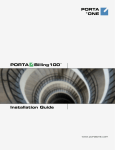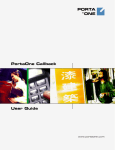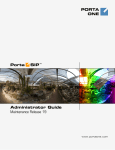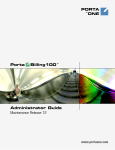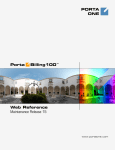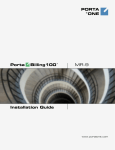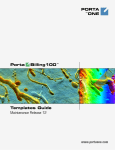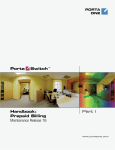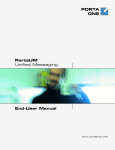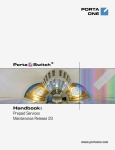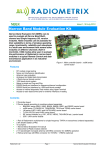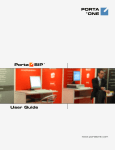Download PortaBilling: User Manual
Transcript
PORTA ® ONE Porta u n i f i e d UM @ m e s s a g i n g Installation Guide MR-11 www.portaone.com PortaUM Installation Copyright Notice & Disclaimers Copyright © 2000-2006 PortaOne, Inc. All rights reserved PortaUM Installation Guide, August 2005 Please address your comments and suggestions to: Sales Department, PortaOne, Inc. Suite 400, 2963 Glen Drive, Coquitlam BC V3B 2P7 Canada. Changes may be made periodically to the information in this publication. Such changes will be incorporated in new editions of the guide. The software described in this document is furnished under a license agreement, and may be used or copied only in accordance with the terms thereof. It is against the law to copy the software on any other medium, except as specifically provided in the license agreement. The licensee may make one copy of the software for backup purposes. No part of this publication may be reproduced, stored in a retrieval system, or transmitted in any form or by any means, electronic, mechanical, photocopied, recorded or otherwise, without the prior written permission of PortaOne Inc. The software license and limited warranty for the accompanying products are set forth in the information packet supplied with the product, and are incorporated herein by this reference. If you cannot locate the software license, contact your PortaOne representative for a copy. All product names mentioned in this manual are for identification purposes only, and are either trademarks or registered trademarks of their respective owners. (c) 2002-2006 PortaOne, Inc. All rights reserved. www.portaone.com 1 PortaUM Installation Table of contents Preface ............................................................................................................................ 3 1. Introduction ...................................................................................4 Hardware and Software Requirements ............................................................... 5 2. Installation Process .....................................................................7 Step Step Step Step Step Step Step Step Step Step Step Step Step Step Step Step Step 3. 1: Insert the USB dongle................................................................................ 8 2: Power-Up, Boot Order Setup................................................................... 8 3: Insert the CD-ROM...................................................................................... 8 4: Launch the installation process .............................................................. 9 5: Welcome Screen ........................................................................................ 10 6: Disk Partitioning - Overview .................................................................. 11 7: Disk Partitioning - Choose Disk ............................................................ 11 8: Disk Partitioning – Slice layout ............................................................. 12 9: PortaSwitch parameters .......................................................................... 12 10: Network Configuration .......................................................................... 13 11: MX Domain Configuration .................................................................... 14 12: Time Zone Configuration...................................................................... 14 13: Setting-up Root Password and User account ............................... 15 14: Start the Installation .............................................................................. 15 15: Prepare to Reboot................................................................................... 17 16: Check that the System Reboots to a Normal State .................... 18 17: Prepare System for Transportation (Optional)............................. 19 Cisco AS5300 Gateway Setup ................................................. 20 Setting-up a Back-to-Back T1/E1 Connection................................................. 21 Other Important Considerations .......................................................................... 23 (c) 2002-2006 PortaOne, Inc. All rights reserved. www.portaone.com 2 PortaUM Installation Preface This document provides a general overview of the PortaUM installation process. Where to get the latest version of this guide The hard copy of this guide is updated at major releases only, and does not always contain the latest material on enhancements occurring inbetween minor releases. The online copy of this guide is always up-todate, integrating the latest changes to the product. You can access the latest copy of this guide at: www.portaone.com/resources/documentation/ Conventions This publication uses the following conventions: Commands and keywords are given in boldface Terminal sessions, console screens, or system file names are displayed in fixed width font Caution indicates that the described action might result in program malfunction or data loss. NOTE: Notes contain helpful suggestions about or references to materials not contained in this manual. Timesaver means that you can save time by performing the action described in the paragraph. Tips provide information that might help you solve a problem. (c) 2002-2006 PortaOne, Inc. All rights reserved. www.portaone.com 3 Introduction 1. Introduction (c) 2002-2006 PortaOne, Inc. All rights reserved. www.portaone.com 4 Introduction PortaUM runs on most modern UNIX operating systems (FreeBSD, Linux, Sun Solaris, etc.), assuming that these are equipped with such basic components as an ANSI C compiler. However, it may be difficult for an inexperienced system administrator to install and configure the operating system in such a way that it meets all the requirements and provides the best performance. Installing all the pre-requisite software (libraries, Perl modules, etc.) can also be a time-consuming task. The PortaUM JumpStart installation CD offers a quick and seamless way of performing a complete server installation from scratch in less than 15 minutes! It contains the installation media for FreeBSD 5.4, including all the necessary packages, plus PortaSIP itself. The installation wizard employs a text-mode GUI. Use the arrow keys to change your selection, “Tab” to move between the fields, space bar to set the check boxes and “Enter” to make a choice. Hardware and Software Requirements PortaUM requires a dedicated Cisco AS 5300/5350. Cisco requirements • • • 128M RAM, 64M flash, E1 or T1 voice ports, sufficient number of DSPs. IOS 12.3.5a (or other from the 12.3 branch). AS5300 comes with 4 or 8 T1/E1's. You will not need more than 4 of them because of DSP resource limitation for AS5300. For T1 configuration maximum voice resource will be 96 and for E1 -- 120. Recommended configuration: Server HW • • • Pentium 4 CPU 3 GHz Motherboard with 533 MHz system bus support 512 MB of RAM Make sure that your servers have been properly installed and equipped with all the required hardware, namely: • • Network card CD-ROM (in the case of an IDE CD-ROM, we recommend that it be connected as a slave on a secondary IDE channel) (c) 2002-2006 PortaOne, Inc. All rights reserved. www.portaone.com 5 Introduction • • Video adapter/monitor/keyboard (required only during the installation process) At least one disk drive of sufficient size. The size of the drive should be selected based on the anticipated amount of PortaUM users, taking the following into consideration: o The operating system and all software packages take up about 2GB of disk space o Approx. 10 GB should be reserved for system use (temporary files, operating logs and such) o One second of recorded audio takes about 10 kilobytes of disk space o One fax page takes about 120 kilobytes of disk space Therefore, if your system is designed to serve, for example, 10,000 users and has an 80 GB disk, you can allocate 6.8 MB for each user, which will be sufficient to store audio messages with a total length of 10 minutes, or about 50 fax pages. Please make sure that other hardware installed in your server (such as network adapter, RAID controller, etc.) is supported by the FreeBSD. You can check this on the FreeBSD web site: http://www.freebsd.org. During installation you will be prompted for your network configuration parameters. Please decide on this matter before beginning installation, consulting your network administrator if necessary. While it is possible that you will have to perform installation before the network is available (in your office, for example, while the servers will be located in a server hosting center), you will still need to enter the correct data. Please have the following ready: • IP addresses of master and slave PortaBilling100 servers • IP address of the PortaSIP server • Name of the MX domain designated for the hostname of the machine running PortaUM • Subnet mask and address of the default gateway • Address of your DNS server If a hardware RAID controller is available in your system, configure the RAID array. Recommended configurations (depending on the number of hard drives in the system) are as follows: • 2 disks – RAID (mirroring) • 3 disks – RAID 1 (mirroring) on the first two disks, with the third one left as a hot spare. (c) 2002-2006 PortaOne, Inc. All rights reserved. www.portaone.com 6 Installation Process 2. Installation Process (c) 2002-2006 PortaOne, Inc. All rights reserved. www.portaone.com 7 Installation Process Step 1: Insert the USB dongle Before you will start the installation, insert the provided USB dongle in one of the available USB ports. Step 2: Power-Up, Boot Order Setup Power-up the computer which you plan to use as a server. Enter the BIOS setup, making sure that the CD-ROM is first in the list of boot devices. If you are installing a dual-server configuration, start your installation with a master server. Note: This image is only an example. The BIOS on your system might look different. Save your changes and exit. Step 3: Insert the CD-ROM While rebooting the system, insert the PortaUM installation CD in the CD-ROM drive. If you do not insert it quickly enough and get a “no operation system” error (or a previously installed operating system starts (c) 2002-2006 PortaOne, Inc. All rights reserved. www.portaone.com 8 Installation Process its boot-up process), press the “Reset” button and make sure that you are booting from the CD. Step 4: Launch the installation process First, it asks for your clarification to boot from the CD You will know that JumpStart installation has begun if you see a screen similar to the following one: Now, before proceeding any further you will see the following screen. (c) 2002-2006 PortaOne, Inc. All rights reserved. www.portaone.com 9 Installation Process If you select first choice it will start the installation for many hardware configurations. But in some cases with the choice 1, it will give you a device mounting error due to some different hardware systems. In this case start the installation again and when you see this screen select the option 2, 3 or both to enable/disable the APIC/ACPI features. For example if you are installing in a computer with a motherboard ASUS P4VP-MX, you have to disable the APIC. In this case at the above screen select 2. Then it will show you the disabled features and asks to press 1 or enter to proceed. Step 5: Welcome Screen Next, the installation process starts. First you will see the PortaUM welcome screen: (c) 2002-2006 PortaOne, Inc. All rights reserved. www.portaone.com 10 Installation Process Press “Enter” to proceed. Step 6: Disk Partitioning - Overview Now you must allocate the hard drive partitions where FreeBSD and PortaUM will be installed. If you have only one hard drive in your system, or your available disks are configured as a single volume array, then next step will be skipped automatically – and you will proceed to Step 8. Step 7: Disk Partitioning - Choose Disk If you have more than one disk in your system, you will have to choose which one you would like to create the FreeBSD partitions on. If in doubt, choose the first disk on the list. (c) 2002-2006 PortaOne, Inc. All rights reserved. www.portaone.com 11 Installation Process Step 8: Disk Partitioning – Slice layout It will prompt you to enter or choose the default slice sizes to hold different file systems. Step 9: PortaSwitch parameters Parameter RADIUS server RADIUS secret RADIUS auth Description IP address of the PB100 master host authentication key for all radius interactions; select a password and write it down, as you will need to enter it later when adding the PortaSIP node to your PB100 system number of UDP ports at which your PB100 accepts (c) 2002-2006 PortaOne, Inc. All rights reserved. www.portaone.com 12 Installation Process port RADIUS acct port RADIUS retransmission interval RADIUS retransmission count authorization requests UDP port which RADIUS server listens for accounting requests number of seconds to wait for reply before retransmitting a RADIUS request maximum number of retransmissions Note: Only radius server and radius key are mandatory to enter. Usually you can just retain the default values for the last 4 parameters. Step 10: Network Configuration Fill the desired fields in this menu for network configuration. (c) 2002-2006 PortaOne, Inc. All rights reserved. www.portaone.com 13 Installation Process Use the space bar to set the check boxes for interface and DHCP. Use the tab key to proceed to the next field. Set the interface that connects to the internet, you can unset the other interfaces, if you have multiple. If you do not use DHCP please unset this box. You can leave empty the alias and ifconfig(8) flags. Step 11: MX Domain Configuration You will need to enter the name of the mail exchange (MX) domain which you plan to use for PortaUM (that is, the name appearing after `@' in mail sent to/from the PortaUM system). You will also have to register this name in the DNS server for your domain. Step 12: Time Zone Configuration Having your clock adjusted properly and setting up a time zone correctly are essential for accurate billing. (c) 2002-2006 PortaOne, Inc. All rights reserved. www.portaone.com 14 Installation Process Step 13: Setting-up Root Password and User account Choosing the super user password is very important. You will need it to perform system administration or system recovery. Choose a password which is difficult to guess or crack. Add another user account especially for remote administration. Step 14: Start the Installation Your confirmation is required before the disk layout is changed and the partitions reformatted. Press “Enter” to proceed. (c) 2002-2006 PortaOne, Inc. All rights reserved. www.portaone.com 15 Installation Process You will see the progress similar to the following screen. During the installation it will ask you to verify UM features enabling on your PortaBilling web interface. (c) 2002-2006 PortaOne, Inc. All rights reserved. www.portaone.com 16 Installation Process If you select yes on the above screen and if you don’t have IP connectivity to PortaBilling slave machine it will prompt you the following screen. If you don’t have the connectivity choose No to proceed. Step 15: Prepare to Reboot Installation is now finished. Press “Enter” when you reach the following screen. Once the system begins its reboot process, remove the installation CD from the CD-ROM. Do not forget to enter BIOS again and change the priority of boot devices so that the hard drive will now be the first boot device attempted. (This ensures faster reboot when recycling the server.) (c) 2002-2006 PortaOne, Inc. All rights reserved. www.portaone.com 17 Installation Process Step 16: Check that the System Reboots to a Normal State It is good idea to make sure that the system is in a stable state, and that it returns to normal operations on reboot without the need for any intervention, especially if no keyboard or other peripherals are to be attached. The screen should look like this after a normal reboot: Press Ctrl + Alt +Del if you need to reboot. (c) 2002-2006 PortaOne, Inc. All rights reserved. www.portaone.com 18 Installation Process Step 17: Prepare System for Transportation (Optional) If you need to transport the system to another location (e.g. hosting center) or otherwise power down the system safely, proceed as follows: • Wait until the system finishes booting • Log in as root • Type shutdown –p now • Wait until either the system powers down on its own or a message reading “The operating system has halted” appears, and then power off the server. (c) 2002-2006 PortaOne, Inc. All rights reserved. www.portaone.com 19 Cisco AS5300 Gateway Setup 3. Cisco AS5300 Gateway Setup (c) 2002-2006 PortaOne, Inc. All rights reserved. www.portaone.com 20 Cisco AS5300 Gateway Setup Setting-up a Back-to-Back T1/E1 Connection Hardware Setup In order to use the Cisco AS5300 gateway as a media server and VXML platform in the PortaUM system, you need to physically loop one or more pairs of T1 or E1 voice ports on it, so that these can be used for the PSTNÆPSTN connection. To do this, construct one or more RJ-48C cross-over cables using the following table: T1/E1 CSU/DSU Cross-Over Pinout From RJ 48C Pin To RJ 48C Pin 1 4 2 5 4 1 5 2 Make sure you count the RJ-48C pins as shown in the illustration below: Alternatively, you can order ready-made ones. You can find a number of vendors producing such cables by searching for “RJ-48C cross-over cable” on www.google.com. Once the cable is ready, plug it into the designated pair of T1/E1 ports in your Cisco AS5300 gateway. (c) 2002-2006 PortaOne, Inc. All rights reserved. www.portaone.com 21 Cisco AS5300 Gateway Setup Software Configuration You also have to configure the T1/E1 interfaces. The sample configuration below is for T1; adjust the time slots for E1: isdn switch-type primary-5ess ! controller T1 0 framing sf clock source line primary linecode ami pri-group timeslots 1-24 ! controller T1 1 framing sf clock source line secondary 1 linecode ami pri-group timeslots 1-24 ! controller T1 2 framing sf linecode ami pri-group timeslots 1-24 ! controller T1 3 framing sf linecode ami pri-group timeslots 1-24 ! interface Serial0:23 no ip address isdn switch-type primary-5ess isdn protocol-emulate network no cdp enable ! interface Serial1:23 no ip address isdn switch-type primary-5ess no cdp enable ! interface Serial2:23 no ip address isdn switch-type primary-5ess isdn protocol-emulate network no cdp enable ! interface Serial3:23 no ip address isdn switch-type primary-5ess no cdp enable (c) 2002-2006 PortaOne, Inc. All rights reserved. www.portaone.com 22 Cisco AS5300 Gateway Setup Other Important Considerations Please ensure that the PortaUM machine and Cisco AS5300 gateway used as a media server and VXML platform have a good network connection between them. Ideally, they should be located on the same 100 Mbps or 1,000 Mbps LAN segment. This is important because the media server needs to load sounds interactively from the PortaUM machine in real time. Therefore, lossy and/or high-delay connections between the media server and the PortaUM machine can significantly impair service quality. Also, it is likely that there will be a significant amount of TCP traffic between the media server and the PortaUM machine, which can be quite expensive if they are not co-located. (c) 2002-2006 PortaOne, Inc. All rights reserved. www.portaone.com 23



























